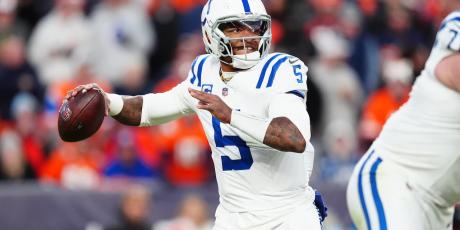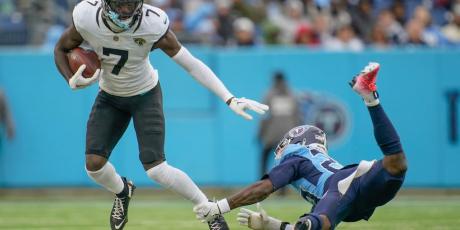A Profitable Gameplan for NFL DFS on DraftKings

We’ve almost reached the time of year when humid turns to crisp, t-shirts turn to sweatshirts, and red laces turn to white. At least that’s how it works here in the northeast. It’s time for football! More specifically, it’s time to start grinding daily fantasy football on DraftKings. Once again in 2019, I’ll be cranking out the weekly DraftKings breakdown. Over the past seven years or so, I’ve developed a process for being a profitable daily fantasy player. In my weekly article, I’ll share with you my favorite cash game and GPP targets. In this article, I’ll break down how I narrow my player pool in both formats, as well as recommendations for bankroll management and contest selection within the DraftKings platform.
Bankroll Management and Contest Selection
I’ve touched on this concept before, as did TJ Hernandez in his FanDuel primer. You should be thinking about your bankroll in terms of the maximum money you’re willing to invest for the season, not how much is in your account. You don’t have to deposit it all Week 1, but have a set amount that you are willing to lose during the course of the year. For instance, If you initially deposit $500, but are willing to make two more deposits of $250 if your initial deposit dries up, your total bankroll for the season adds up to $1,000. You would calculate all weekly money in play from that $1,000, no matter the amount currently in your account.
By nature, I'm a fairly conservative player in terms of bankroll allotted per week towards cash and GPP. I often play upwards of 90% of my weekly bankroll in cash games. This allows me to play a greater percentage of my overall bankroll each week, due to the vast majority of my money in play being in less volatile head-to-heads and double-ups. Below is a general chart you can use to gauge the amount of money you should have in play based on your personal leanings toward cash or GPP concentrated contest selection.
| % of Bankroll in Play | % in cash games | % in GPP | Risk Tolerance |
|---|---|---|---|
| 10-12 | 90% | 10% | Low |
| 7-9 | 75% | 25% | Medium |
| 4-6 | 60% | 40% | High |
For guidance on which contests you are good at cashing, I suggest downloading your DraftKings CSV file and loading it into an analyzer. You can use this to determine which type of contests you have the highest historical cash rate in. You can even break it down by entry amount, field size, contest type, or entry limits. It’s a useful tool to spot trends. For instance, you often see a blanket recommendation across the DFS industry to play most of your cash game budget in head-to-head contests. For me, however, I have a much higher cash rate in double-ups compared to head-to-head contests. Therefore, I get more double up and 50/50 action than normally prescribed. I encourage you to analyze your strengths and shift your contest selection and bankroll allotment to fit that style of play.
It’s important to take contest selection a step further and narrow down what types of double-ups or GPPs you should be playing in. During the offseason, I looked at historical cash lines for double up contests. I had educated guesses going into the research, but I wanted data-driven answers to some of the questions I often had about these cash games. Is single-entry softer than multi-entry? If I want to play $100 in double-ups, should I run a 20-team train of the same lineup in the $5 or should I play one lineup in the $100 single-entry? These stats don’t include the incredibly small double-ups that have only a handful of entrants, just the larger field contests, which you should be sticking to, anyway. Here are some key stats that I found.
- The softest (lowest cash line) contest on DraftKings is usually the single-entry $5 double-up.
- On average, every single entry contest had a lower cash line than the multi-entry contests of the same dollar amount.
- In 2018, the $100 single entry double-ups had a lower cash line than the multi-entry $10 in 14 of 17 weeks. Additionally, in two of the three weeks that the multi-entry $10 had a lower cash line, it was by less than one point.
The main takeaway is that you should get all your cash game exposure from large-field single-entry double-ups, if you're opting for these game types over head-to-heads. If you have a large bankroll and still need more exposure, max out the $2 multi-entry. The reason these single-entry contests are softer is easily explained. In the multi-entry contests, there are a lot of sharp players entering their lineup up tp 100 times. This results in fewer people cashing because certain players take up multiple spots above the cash line.
Cash Game Player Selection
In cash games, my objective is to get the most projected points, plain and simple. At the quarterback position, I look for positive game script, passing tendencies of coordinators, rushing upside, projected team total, and matchup. For running backs, volume is king. I’m usually targeting two or three high-priced ball carriers that play on every down. Using a large percentage of salary on running backs has proven to be a profitable approach over time. Their workloads translate to fantasy points more efficiently than wide receivers or tight ends because carries and short targets are high percentage plays in terms of generating fantasy points.
I again look for volume at the wide receiver and tight end position. I generally trend towards value-to-average salary range for receivers for two reasons. The first is because the majority of my salary has been spent on running backs, but also because a large percentage of value-to-average priced receivers return value. In 2018, wide receivers in the $4,000-$5,000 range had the highest hit rate in terms of returning cash value based on salary. This meshes well with the fact that I like spending up on running backs.
Tight end was a tricky beast in 2018 as much of the value ended up disappointing us week in and week out. It caused a shift in strategy over the course of the season. Tight ends that were used as receivers on their respective teams, like Travis Kelce, Zach Ertz, and George Kittle were routinely priced as WR2s despite often ending up as their team's WR1. I placed an emphasis on rostering one of them each week in cash as they were often easier to project than most wide receivers. Overall, I use the great tools at 4for4, like John Paulsen’s projections to spot value, couple that with my favorite high-usage running backs and positive game script quarterbacks to create a pool of players for you to create your cash game lineup(s).
GPP Player Selection
My GPP player pool consists of my favorite cash game plays plus players that have a high-ceiling and a projected low-ownership. Using 4fo4’s GPP Leverage tool is the easiest way to spot these players as it factors in player projections and ownership projections to determine which players are going overlooked. I also use the stack value reports, which is basically a tool that finds the highest combined GPP Leverage Scores for team stacks. Below are some key stats about winning Millionaire Maker teams over the last 33 contests. Keep these in mind when building lineups in 2019:
- The average ownership of the RB1 and RB2 position was 25.2% and 16.1% respectively. This makes sense as there isn't a ton of running backs capable of a workload that leads to a monster fantasy output. Don’t go too off the beaten path at the RB position.
- In fact, 85 different running backs were rostered across the last three winning Millionaire Maker squads and only 13 were under 10% owned.
- Conversely, 61/111 wide receivers that were rostered on the last 33 Millionaire Maker winning teams were under 10% owned and 41 were under 5% owned. The volatility at the wide receiver position makes it a good position to fade some of the projected chalk. Chalk wide receivers can absolutely be on winning GPP rosters, but the hit rate for highly-owned wide receivers is incredibly low in terms of returning GPP value.
- Only 10/33 winning Millionaire Maker teams “ran it back” with an opposing player. If the only reason you are forcing a player into your player pool is that he is on the opposing team of one of your favorite stacks for the week, you may want to reconsider.
- Winners rostered running backs in the flex, but not overwhelmingly: RB - 19, WR - 12, TE - 1
- The max amount of salary left on the table was $600, but more than half the weeks (17/33) the winner used all $50,000 of salary.
Creating lineups and entering them into contests requires a lot more than just mashing buttons of your favorite players each week. As I outlined above, the process requires attention to detail in terms of bankroll management, contest selection, and player selection. With the help of 4for4’s projections and DFS tools, my article will assist you in creating a cash game lineup with a high floor and a touch of upside as well as a GPP player portfolio designed to leverage the field in the appropriate ways. Let’s get after it in 2019!






















